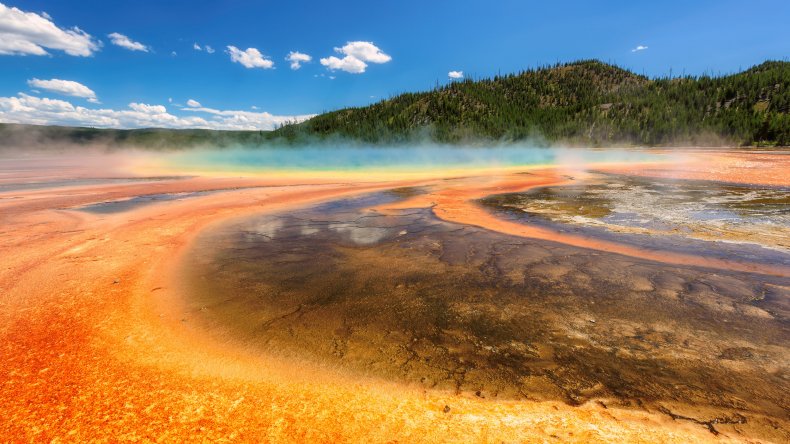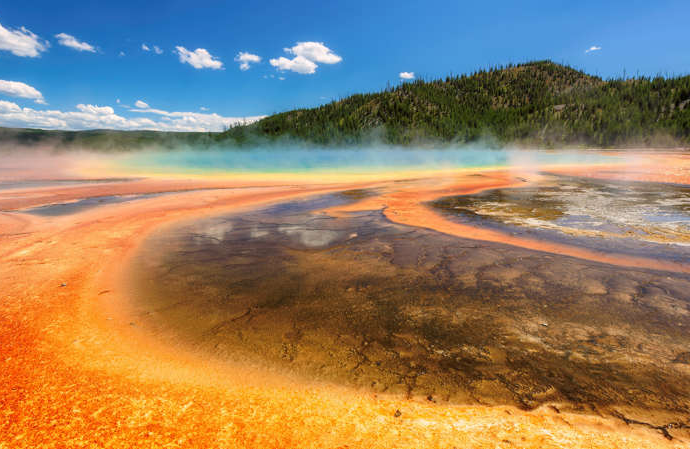The last supereruption at Yellowstone volcano was preceded by multiple explosions taking place over the course of decades, scientists have discovered. The Lava Creek Tuff eruption took place 631,000 years ago and researchers studying the event have found unexpected rock deposits that suggest the event was far more complicated than previously thought.
Source: Newsweek
Yellowstone has produced several huge, caldera-forming eruptions. A blast 2.1 million years ago—known as the Huckleberry Ridge Tuff eruption—was so huge the ground above the magma chamber collapsed, leaving a crater 50 miles long and 40 miles wide. Another huge supereruption 631,000 years ago expelled 1,000 cubic kilometers (240 cubic miles) of rock and left ash deposits across the western U.S., southern Canada and northern Mexico.
Last year scientists also announced two earlier supereruptions, with the biggest taking place 8.7 million years ago. This event, known as the Grey’s Landing supereruption, saw an area the size of New Jersey covered with searing hot volcanic glass.
Along with these supereruptions, there have been multiple smaller episodes of volcanic activity at Yellowstone, with the last taking place 70,000 years ago. It is unlikely the volcano will produce another supereruption for thousands, if not hundreds of thousands, of years. However, understanding how these supereruptions unfolded may shed light on what could happen in the run-up to the next massive event at Yellowstone.
In the latest “Caldera Chronicle”—a weekly column by scientists published on the USGS Yellowstone Volcano Observatory website—researchers looked at the Lava Creek Tuff eruption 631,000 years ago.
Raymond Salazar and Madison Myers, from Montana State University, together with Colin Wilson, from the Victoria University of Wellington, New Zealand, said their work in the Sour Creek Dome region, which sits on the east of the national park, has revealed a set of ignimbrite units that were thought to belong to the Huckleberry Ridge Tuff eruption were actually from the Lava Creek Tuff eruption.
Ignimbrite units are like sheets of volcanic deposits that are deposited during volcanic events.
The older ignimbrite unit, they say, must have been erupted, cooled, then broken up and transported before the next explosive event. Unit 2 was deposited on top of unit 1. “Since large ignimbrites take a long time to completely cool, these deposits suggest that there was a break between the two events of years to decades,” they wrote. “And all this happened before any of the material mapped previously as the Lava Creek Tuff was erupted.”
“The picture that emerges is of a complex sequence that started with multiple explosive events that might have been separated by years to decades before the better-mapped explosive eruptions ensued.”
This discovery follows similar findings at the Huckleberry Ridge eruption last year, where researchers found the event 2.1 million years ago took place over decades, rather than being a single event.
Salazar now plans to re-map the South Creek Dome area and collect samples to better identify the pre-eruptive magma compositions that would allow researchers to work out the depth and temperature of the magma chamber. “The importance of this information lies in determining whether these two new units were ‘leaks’ of a single large ‘Lava Creek magma body,’ or were separate pools of magma, as well as trying to understand what triggered these earlier outbreaks,” the team wrote.

Source: Newsweek

































Leave a Comment
You must be logged in to post a comment.